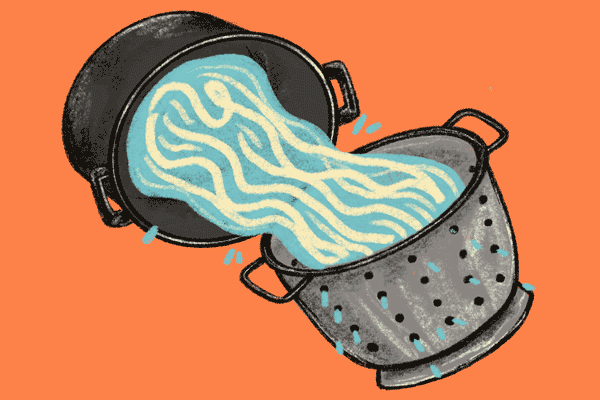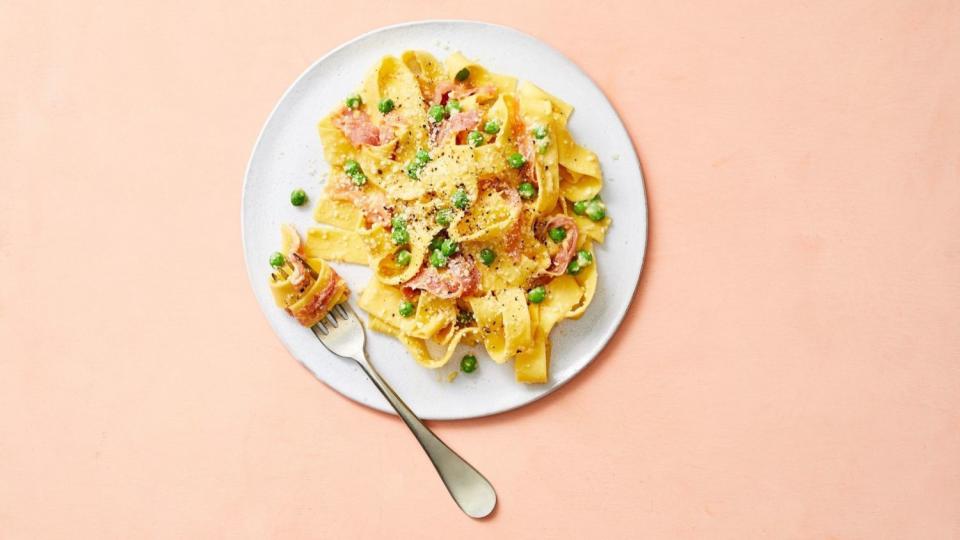How to Boil Water: Boiling pasta (plus three-ingredient spaghetti carbonara)

With so many of you having to stay home and cook for the first time — ever or more than you have in a long time — we get that it can be overwhelming to have to cook all your meals from scratch. So we’re here to get you started.
Each weekday, we’re going to post a new skill here and go in detail about how to do it — a resource for cooking basics so you can get food on the table and get through this.
Lesson 12: Boiling pasta (plus three-ingredient spaghetti carbonara!)
When we launched this column, my daughters asked (imagine teenage sarcasm here), “How hard is it to boil water?” Well, it’s not hard, but there is a right way to do it — especially if pasta is going into it.
First, fill a large pot about two-thirds with water (4 to 5 quarts) for every pound of pasta (scale the amount down for less), cover it and wait for it to come to a rolling boil. A big pot of water comes back to a boil faster, making it easier for long pastas to soften and bend into the liquid if you don’t have a wide pot and prevents all pasta shapes from clumping.
Before adding the pasta, add lots of salt. I usually fill my palm with Diamond Crystal kosher salt (about 2 tablespoons) and tip it into the big bubbles. A tablespoon of sea salt, fine or coarse, or 1 ½ tablespoons Morton’s kosher salt offer the equivalent saltiness. It seems like a lot, but in all that water, it’s what you need to season the pasta all the way through.
Once the water comes back to a near violent boil, drop in all the pasta at once and start stirring right away. Keep stirring until bubbles reappear to prevent the pasta from gluing together. And keep going a little longer for the cuts that stick more than others — I’m looking at you, linguine and orecchiette.
Set a timer for 2 minutes less than the al dente cooking time on the box. (While you’re waiting, make sure your sauce is ready to go, simmering if it should be hot.) Stir your noodles now and again while they bounce in the boiling water. When the timer goes off, use a liquid measuring cup to scoop out a cup of water and set it aside. Use tongs to pull out a piece of pasta, rinse it under cold water to cool it down a bit and bite into it. It should still be solidly opaque in the center if it’s going into a simmering sauce. Otherwise, it should have just the tiniest uncooked bit in the middle. If needed, cook a minute or two more, bite-checking at each interval.
As soon as the pasta hits the right doneness, drain in a colander and slide into the pot of sauce. Don’t rinse! You need the pasta to be hot and starchy to latch on to the sauce. Toss for a few minutes until the noodles are very evenly coated, and if you drained it when it was extra al dente, make sure it is cooked through to your liking. In any case, add a spoonful or more of the reserved cooking water to give the sauce a silky smoothness.

Three-Ingredient Spaghetti Carbonara
20 minutes. Serves 4 to 6.
I’m down to basic staples in my fridge and pantry. Maybe you are too. So even though carbonara traditionally includes cured pork, such as guanciale or pancetta, and Pecorino Romano cheese, it’s still tasty without meat and with just Parmesan. You simply cook the noodles to the doneness you want, drain them and let them vent off some steam and cool a bit before tipping them into the egg-cheese mix. (If the pasta is too hot, it’ll scramble the eggs and give you a lumpy sauce.) Keep tossing until the duo becomes creamy and clings to the noodles. Add a spoonful or two of the reserved pasta water as the sauce starts to thicken to keep it slick. Serve right away with plenty of black pepper on top and even more cheese if you want — and cured pork if you have it.
1 pound spaghetti
4 large eggs, room temperature
2 cups finely grated Parmesan or Pecorino cheese or a combination
1. Bring a large pot of water to a rolling boil. Add a lot of salt (1 to 2 tablespoons) and bring back to a boil. Add the spaghetti and stir well, then boil for a minute less than the package directs, stirring occasionally.
2. Meanwhile, whisk the eggs in a large bowl until well-blended but not bubbly, then stir in the cheese.
3. Scoop out a cup of the pasta cooking water, then drain the pasta in a colander. Shake the spaghetti in the colander until it stops steaming, 15 to 30 seconds, then immediately add to the egg mixture. Gently toss with tongs until the cheese melts into a sauce and the spaghetti is well-coated. Add a tablespoon reserved pasta water and keep tossing until the sauce is very silky, adding another tablespoon water if the sauce is stiff.
4. Season the pasta to taste with salt and pepper, then divide among serving plates. Grind more pepper on top and serve immediately.
Variation
Meaty Carbonara: If you have guanciale, pancetta or even bacon, dice 4 ounces. Add only 1 tablespoon salt to the boiling water. Spread the cured pork in a skillet and set over medium heat. Cook, stirring occasionally, until the fat renders and the meat is golden. Scrape the meat and fat into the pasta with the egg-cheese mixture and toss together.
If you have more ingredients on hand, try spring pea carbonara, Marcella Hazan's carbonara or even squid carbonara.

